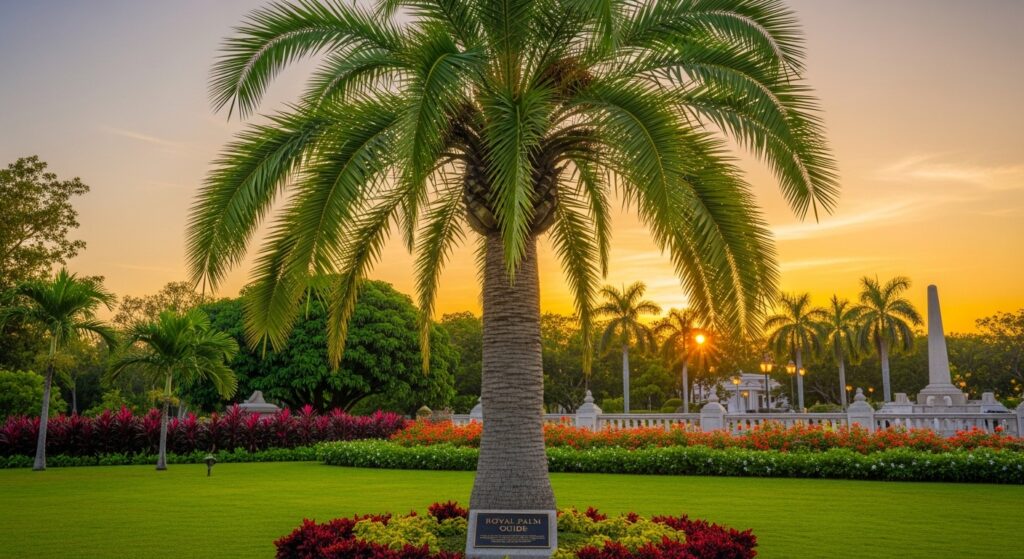Introduction:
The Royal Palm Tree (Roystonea regia) stands tall as one of the most remarkable symbols of tropical beauty. With its sleek, grayish trunk towering structure and rich green leaves, this palm captures attention wherever it grows. Landscapers, homeowners, and city designers often rely on it to create eye-catching scenery. This impressive palm plays a key role in ornamental gardening, enhancing everything from private mansions to public parks and even coastal roadsides with its striking appearance.
Planting a royal palm tree in your garden adds beauty and brings a peaceful tropical vibe. These palms come from places like Cuba, southern Florida, Central America, and the Caribbean, where it stays warm and humid. They handle different soils well and stay strong even in tough conditions. Since they do not need much care, they work well for gardeners who want a bold yet easy-to-manage feature in their outdoor spaces.
This guide dives deep into everything about the royal palm tree. It covers its key traits, how it benefits the environment, tips to care for it, how to grow new ones, and even fun ideas to use it in your yard. If you’re just starting out in gardening or have years of experience, this guide helps you learn more about growing these stately trees and turning your backyard into a tropical escape.

The royal palm tree has features that make it different from other palms. grown trees reach 70–100 feet tall, and under the best conditions, some can hit 120 feet. Its smooth trunk, light gray and resembling polished stone, stretches straight up, making a striking match with the bright green leaves above.
One thing that stands out is the crown shaft. This shiny green part sits right under the fronds and makes the tree look neat and well-groomed. This smooth, tube-like section not only improves its overall look but also helps tell it apart from palms such as the coconut palm or the date palm. The crown shaft can shed old fronds on its own, keeping the trunk spotless and looking clean.
The feathered leaves called fronds stretch out like an arch from the top of the tree and can grow to be 10 to 12 feet long. They move with the wind, creating patterns of light and shadow that bring a calm tropical feel. Their bright green color and flowing motion draw attention, making the royal palm tree stand out in any setting.
Extra Features: The royal palm tree grows roots that spread widely but stay close to the surface. This gives the tree strong support while avoiding harm to nearby structures like sidewalks or building foundations. Beneath the crown shaft, small creamy-white flowers appear in bunches and attract pollinators like bees and butterflies. These flowers turn into tiny purple-black fruits. Even though people cannot eat them, birds and animals feed on them, making this tree important for its role in nature. People do not harvest the wood, but it is dense and tough. In the past, some areas used it to build small things or make crafts.
Importance in History and Culture of the Royal Palm Tree
The royal palm tree has an important role in history and local traditions where it grows. In Cuba, people see it as a national symbol of strength, elegance, and national pride. The country’s coat of arms includes the image of this tree, showing how much it means to their cultural identity. Long before colonization, native people used the palm’s leaves to make roofs and its fruits to feed animals, which highlights its usefulness in everyday life.
In the 1800s and early 1900s, people used royal palms to decorate tropical landscapes in the Americas. In Florida, they were planted near big mansions and public streets to show wealth and importance. Cities such as Miami and Havana used them a lot, lining parks and streets to create views that looked like they came from a postcard.
Around the world, royal palms were sent to areas with tropical and subtropical climates, like Southeast Asia and Australia. They are often added to resorts, city parks, and botanical gardens. Their charm comes from how they bring a sense of exotic beauty, making them a popular choice for places that rely on tourism.
Economic Importance:
Royal palms support local economies in ways beyond just their appearance. Tourism and landscaping industries gain from their use. Resorts in places like the Caribbean feature them in their landscapes to draw tourists, which increases earnings in hospitality. Tropical plant nurseries also make money by growing and selling royal palm saplings. These saplings are popular for homes and business projects.
Why You Should Grow a Royal Palm Tree
The royal palm tree provides many advantages beyond just looking great. Its big leaves give shade, making it a nice spot to relax or hang out during hot weather. Placing a royal palm tree in the right spot can help cool homes, patios, or pools and save energy by cutting cooling costs. Research shows that mature shade trees can bring down air temperature by 5 to 10 degrees Fahrenheit, which makes royal palms a smart pick for hot regions.
Once grown, royal palms don’t need much care. They handle dry spells well, so you don’t have to water them often. This helps save water and fits with eco-friendly gardening practices. Because of this, they work well in landscaping that focuses on using less water.
Royal palms boost both property value and visual charm. Real estate studies show that a well-kept palm can raise property value by 5–15%. These trees make homes stand out with their eye-catching appearance and appeal to buyers looking for a tropical or vacation-like vibe.
They also help nature by supporting biodiversity. Wildlife uses royal palms for food and shelter. Birds like parrots and doves eat their fruits, while small animals and bugs find shelter in their fronds. In coastal areas, the strong roots of these palms prevent soil from wearing away due to water or wind. Plus, their leafy tops soak up carbon, which helps fight climate change.
Health and Wellness:
Royal palm tree fin a garden can help people feel better. Research shows green spaces help lower stress and lift spirits. The royal palm tree adds to this with its tropical vibe, giving a peaceful, vacation-like feeling that makes life feel better overall.
How to Grow Royal Palm Trees
To grow royal palms, meeting their ideal growing conditions matters. These trees do best in tropical or subtropical areas in USDA Hardiness Zones 10 to 11, where it does not often drop below 32°F. In colder places, you can plant them in pots to bring inside during winter or in protected areas like next to walls that face the sun, which can shield them from frost.
Healthy soil is key when planting royal palms. These trees grow best in well-draining soil mixed with organic materials such as compost or peat moss. They can adapt to sandy, loamy, or clay-based soils, but the soil’s pH must stay between 6.0 and 7.5 to allow proper nutrient absorption. Bad drainage may cause root rot, so it is important to check how well the soil drains. You can do this by digging a 12-inch hole, pouring in water, and seeing if it clears out within 2 to 3 hours.
Getting 6 to 8 hours of sunlight each day is needed to help these plants grow strong. Place them in spots where shade from buildings, walls, or taller trees does not block the light, or they might grow crooked or struggle. In coastal areas, royal palms handle moderate salt in the air, so they work well near the beach. However, they should stay protected from strong ocean winds.
To create warmth in tricky climates, plant them by light-colored walls that bounce heat back. Do not use low spots where cold air gathers because frost can harm young trees. To protect coastal plantings, you can add hedges or fences to block some of the wind and salt effects.
Water Needs:
Royal palms, once they settle in, can handle dry spells. During their first 1 to 2 years, they need steady watering. Give them 1 to 2 inches of water every week, but change that amount depending on rain or the kind of soil. Too much water hurts the roots, so check soil moisture with a meter.
Planting your royal palm the right way gives it a strong start. Use this step-by-step guide.
Pick the Right Spot: Find a sunny area with good-draining soil. Make sure there’s enough room, since these trees grow tall (70–100 feet) and their canopy stretches wide (15–20 feet). Keep it away from power lines, buildings, or underground pipes to avoid future issues.
- Get the Soil Ready: Check how well the soil drains and test its pH levels. If the soil is heavy clay, mix in sand, compost, or peat moss to make it better for roots to breathe and water to flow. Dig a hole that’s twice as wide and deep as the tree’s root ball so roots can spread.
- Planting the Tree: Take the sapling carefully out of its container and check the roots to spot any damage. Put it in the hole so the top of the root ball stays even or a bit higher than the soil nearby. This helps stop water from gathering there. Fill the hole with improved soil and press it to remove air pockets.
- Watering: After planting, water the sapling. Use 10 to 15 gallons for smaller saplings and 20 to 25 for bigger ones, so the soil settles well. During the first 6 to 12 months, water it two or three times a week, giving it 1 or 2 inches of water each time. After the roots spread, water less often based on how moist the soil feels.
- Mulching: Spread an organic mulch layer about 2 to 3 inches thick, like bark, wood chips, or pine straw, around the base of the tree. Extend it outwards by 2 to 3 feet, but leave 2 to 3 inches of space around the trunk to avoid fungal problems. Mulch helps the soil hold moisture, keeps the temperature steady, and blocks weeds.
- Staking (Optional): Place three stakes around young or wind-exposed trees, and use soft, flexible ties to secure them. Take the stakes out after 6 to 12 months so the trunk can grow stronger.
Start fertilization after 4 to 6 weeks of planting. Use a slow-release fertilizer designed for palms (8-2-12 or 12-4-12 NPK) to help roots grow properly. Skip fertilizing during planting because it might harm the roots.
Plant royal palms at a distance of 15 to 20 feet to give the canopy space to spread. This avoids competition among plants for nutrients. Such spacing works well to create a balanced look, making it great for driveways or formal garden layouts.
Keeping your royal palm tree looking good and in good shape needs ongoing attention.
Maintenance and Care Tips
Watering:
Once the tree is established after one or two years, make sure to water it every week or so during dry spells. Provide around 15 to 20 gallons each time to soak the root area. Stay away from shallow and regular watering since it leads to weaker roots. For larger gardens, use drip irrigation to keep the soil evenly moist.
Fertilization:
In spring and twice during summer, use a slow-release fertilizer designed for palms, like an 8-2-12 or 12-4-12 NPK that includes nutrients such as magnesium and manganese. Spread the fertilizer under the tree’s branches, but keep it away from the trunk. Water it in after applying. Plan to test the soil every year to adjust the nutrients as needed.
Pest and Disease Control:
Check the fronds, trunk, and crown shaft each month to spot pests like spider mites or scale and diseases such as Ganoderma or bud rot. Battle pests using horticultural oil or insecticidal soap, and tackle early fungal problems with fungicides. Cut off and get rid of any infected plant pieces to stop the problem from spreading.
Hurricane Preparedness:
If you live in an area with storms, stabilize young trees using a tripod staking system before hurricane season begins. Grown royal palms hold up well in strong winds since they lose fronds to lessen drag, but after storms, look out for loose fronds or clutter to avoid accidents or harm.
Winter Protection:
In zones 9b to 10a, wrap young tree trunks with burlap or frost cloth during cold spells that happen. Add warmth by using heat cables or string lights, but make sure they don’t touch the tree.
Better Care Methods:
You can install a soil moisture sensor to control watering and avoid overwatering. Check the soil’s condition once a year with a digital pH meter, then adjust the levels using sulfur or lime depending on the results. If your property is huge, think about setting up a fertigation system to provide nutrients through irrigation.
Seed Pod Removal:
Remove heavy seed clusters to reduce strain and debris. Wear gloves, as fruits can stain skin and clothing.
Use Proper Tools:
Employ sharp, sterilized pruning shears or a pole saw. Disinfect tools with a 10% bleach solution between trees to prevent disease spread.
Timing:
Prune in late spring or early summer when the tree is actively growing, avoiding stress during cooler months.
Safety Note:
For trees over 20 feet, hire a certified arborist with climbing gear to ensure safety and proper technique. Falling fronds can cause injury or property damage.
Landscaping Ideas Featuring the Royal Palm Tree
Royal palms are versatile in landscape design, enhancing various styles. Here are creative ideas:
- Tropical Oasis: Pair royal palms with lush plants like gingers, helices, and banana plants for a dense, jungle-like garden. Add a water feature (pond or fountain) to amplify the tropical ambience.
- Driveway Lining: Plant royal palms in staggered rows along a driveway or pathway for a formal, resort-style entrance. Use low-maintenance groundcovers like mondo grass or gravel for a clean look.
- Poolside Retreat: Frame a pool with royal palms for shade and privacy. Surround with paver stones and accent plants like bromeliads or agaves for a luxurious vibe. Plant at least 10–15 feet from the pool to minimize debris.
- Minimalist Modern: Use a single royal palm tree as a sculptural centerpiece in a gravel or concrete courtyard. Accent with geometric planters or succulents for a sleek, contemporary design.
- Wildlife Haven: Combine royal palms with native plants like saw palmetto, coontie, or sea grape to attract pollinators and birds. Install nesting boxes or bat houses in the fronds to encourage biodiversity.
- Urban Elegance: In small urban spaces, plant a single royal palm tree in a raised bed or large container, paired with low-growing ferns or ornamental grasses. This creates a tropical focal point without overwhelming limited space.
- Design Tip: Use LED uplights or solar-powered spotlights to highlight the trunk and crown shaft at night, creating a dramatic, resort-like atmosphere. Ensure lights are angled to avoid glare and comply with local regulations.
Environmental Adaptations and Resilience
Royal palms are well-adapted to tropical environments but face challenges in changing climates. Their wind-resistant structure, with flexible trunks and shedding fronds, allows them to withstand hurricanes and tropical storms, making them ideal for coastal regions. However, rising sea levels and increased salinity in coastal soils can stress roots, requiring careful site selection and soil management.
In urban settings, royal palms tolerate moderate air pollution and compacted soils better than many tropical trees, but they require regular maintenance to thrive. Their ability to sequester carbon and provide shade makes them valuable for mitigating urban heat islands, where temperatures can be 5–10°F higher than in rural areas.
Climate Change Considerations:
As temperatures rise, royal palms may expand their range into warmer parts of Zone 9, but increased storm intensity necessitates robust staking and pruning practices. In drought-prone areas, mulch and drip irrigation can mitigate water stress, ensuring long-term resilience.
Conclusion: The Royal Palm Tree in Your Garden
The Royal Palm Tree is more than a botanical marvel; it’s a symbol of grace, resilience, and tropical grandeur. Its towering presence, ecological contributions, and cultural significance make it a transformative addition to any landscape. By mastering its care, propagation, and design potential, you can create a garden that captivates and inspires.
From enhancing property value to supporting biodiversity, the royal palm delivers unparalleled benefits. Whether you’re crafting a tropical oasis, lining a grand driveway, or contributing to a sustainable ecosystem, this majestic tree rewards your efforts with timeless beauty. With expert care and creative vision, your royal palm will stand as a testament to your gardening prowess, thriving for generations.
Ready to embrace the majesty of the royal palm tree? Follow our comprehensive planting and care guide, and explore innovative design ideas to bring your tropical vision to life. Cultivate the elegance of this iconic palm and create the paradise you’ve always dreamed of.

















